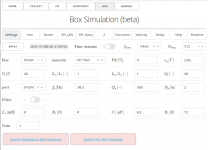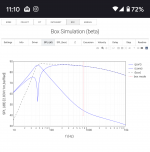Speakerbench -- part 11
Fit Quality Assessment
By performing three impedance measurements instead of two (as in the classic added-mass method), the pure motional impedance can be extracted with a minimum of model assumptions. From this pure motional impedance, the viscoelastic parameter, β, is then determined. The remaining blocked-electrical impedance can be derived by a relatively simple set of algebraic operations. As part of the analysis, the algorithm attempts to extract a stable value of Bl over a region of about one octave around the resonant frequency. This approach gives a useful indication of the robustness of the overall fit.
After the fitting procedure is complete (step 6) the fit quality is automatically assessed. In the Quality tab of the FIT app, a fit rating is provided (see fit.png in part 10). This means you don't have to be an expert in analyzing the output from the fitter. Possible ratings are
Beyond these simple ratings, the user can also study the graphs in the succeeding tabs, where the app provides plots of the motional impedance (ZM), the blocked-electrical impedance (ZE), a model test which essentially compares your three measurements with the simulations based on the established model parameters, and Bl over the fit range. To get an excellent rating probably requires some practice and experimentation with the added mass approach. The good rating is nevertheless sufficient for reasonably accurate box simulations. The Speakerbench article in the Loudspeaker Industry Sourcebook 2020 explains more about this (Ref 4).
Fit Quality Assessment
By performing three impedance measurements instead of two (as in the classic added-mass method), the pure motional impedance can be extracted with a minimum of model assumptions. From this pure motional impedance, the viscoelastic parameter, β, is then determined. The remaining blocked-electrical impedance can be derived by a relatively simple set of algebraic operations. As part of the analysis, the algorithm attempts to extract a stable value of Bl over a region of about one octave around the resonant frequency. This approach gives a useful indication of the robustness of the overall fit.
After the fitting procedure is complete (step 6) the fit quality is automatically assessed. In the Quality tab of the FIT app, a fit rating is provided (see fit.png in part 10). This means you don't have to be an expert in analyzing the output from the fitter. Possible ratings are
(1) EXCELLENT, (2) GOOD, (3) FAIR, and (4) FAIL.
Beyond these simple ratings, the user can also study the graphs in the succeeding tabs, where the app provides plots of the motional impedance (ZM), the blocked-electrical impedance (ZE), a model test which essentially compares your three measurements with the simulations based on the established model parameters, and Bl over the fit range. To get an excellent rating probably requires some practice and experimentation with the added mass approach. The good rating is nevertheless sufficient for reasonably accurate box simulations. The Speakerbench article in the Loudspeaker Industry Sourcebook 2020 explains more about this (Ref 4).
Speakerbench -- part 12
Box simulations with Speakerbench
Speakerbench wasn't initially intended to do box simulations, but there were numerous motivations to offer this functionality. Once an SBD file is created or uploaded, the transducer parameters are automatically forwarded into the BOX app (see box.png), and an initial proposal for a box is provided. Just push the BOX button at the top. You can then explore the Settings to find an optimal configuration. In the box simulator you may specify the usual box parameters, including damping material, input voltage, box volume, port model, tuning frequency and even a simple passive filter. The usual array of plots are produced, including the step response which is calculated with a special-purpose algorithm that is compatible with the non-polynomial form of the advanced response function. At the bottom of the GUI you can upload SPL or impedance measurements and compare with the simulation.
Some aspects of the box model -- particularly enclosure geometry and fill effects -- will be improved over time.
Box simulations with Speakerbench
Speakerbench wasn't initially intended to do box simulations, but there were numerous motivations to offer this functionality. Once an SBD file is created or uploaded, the transducer parameters are automatically forwarded into the BOX app (see box.png), and an initial proposal for a box is provided. Just push the BOX button at the top. You can then explore the Settings to find an optimal configuration. In the box simulator you may specify the usual box parameters, including damping material, input voltage, box volume, port model, tuning frequency and even a simple passive filter. The usual array of plots are produced, including the step response which is calculated with a special-purpose algorithm that is compatible with the non-polynomial form of the advanced response function. At the bottom of the GUI you can upload SPL or impedance measurements and compare with the simulation.
Some aspects of the box model -- particularly enclosure geometry and fill effects -- will be improved over time.
Attachments
Speakerbench -- part 13
JSON Format and Portability
Speakerbench makes use of JSON as a standard container for calculation and datasheet output. This way you can share datasheets and simulations easily with fellow speaker designers. An online database of datasheets (SBD files) could easily be deployed, if desired. If someone sends you a Z-file or ADV-file or SBD-file, you can download it to your smartphone and then drop it into Speakerbench running on a browser. Or you can run it directly on your smartphone or tablet (see attached image).
JSON Format and Portability
Speakerbench makes use of JSON as a standard container for calculation and datasheet output. This way you can share datasheets and simulations easily with fellow speaker designers. An online database of datasheets (SBD files) could easily be deployed, if desired. If someone sends you a Z-file or ADV-file or SBD-file, you can download it to your smartphone and then drop it into Speakerbench running on a browser. Or you can run it directly on your smartphone or tablet (see attached image).
Attachments
Speakerbench -- part 14
Why Speakerbench?
What makes Speakerbench unique is that high-quality transducer data can ensured even for the do-it-yourself speaker builder. The improvement in accuracy with the advanced model can be readily achieved, and should prove useful particularly when quantifying the various box losses. The user should be able to easily and accurately determine a suitable box volume. Speaker designers (DIYers or professionals) rarely build more than one box to determine the optimal volume for a loudspeaker system. With that one prototype box, you just have to make things work. This explains why it is so important to determine the best box volume and port tuning from the very beginning.
Moreover, Speakerbench is a web-app and works on any computer, tablet or smartphone with a browser without any software installation required. The online version will always be up-to-date with the latest that we have made available. Speakerbench collects the research and the proposed methods into an easily accessible software suite. We do the software development, as well as the underlying research and modeling, to help the industry move forward and improve their methods. It is our hope that Speakerbench will facilitate the jump from legacy Thiele/Small parameters to more advanced modeling, and that people will feel like giving it a chance. A manual is available on the website, and in addition we have created a series of short tutorial videos available on YouTube.
Why Speakerbench?
What makes Speakerbench unique is that high-quality transducer data can ensured even for the do-it-yourself speaker builder. The improvement in accuracy with the advanced model can be readily achieved, and should prove useful particularly when quantifying the various box losses. The user should be able to easily and accurately determine a suitable box volume. Speaker designers (DIYers or professionals) rarely build more than one box to determine the optimal volume for a loudspeaker system. With that one prototype box, you just have to make things work. This explains why it is so important to determine the best box volume and port tuning from the very beginning.
Moreover, Speakerbench is a web-app and works on any computer, tablet or smartphone with a browser without any software installation required. The online version will always be up-to-date with the latest that we have made available. Speakerbench collects the research and the proposed methods into an easily accessible software suite. We do the software development, as well as the underlying research and modeling, to help the industry move forward and improve their methods. It is our hope that Speakerbench will facilitate the jump from legacy Thiele/Small parameters to more advanced modeling, and that people will feel like giving it a chance. A manual is available on the website, and in addition we have created a series of short tutorial videos available on YouTube.
Speakerbench -- part 15
References
(1) R. Small, Vented-Box Loudspeaker Systems -- Part 1: Small-Signal Analysis, J. Audio Eng. Soc. 21 (1973) 363
(2) C. Futtrup, Losses in Loudspeaker Enclosures, AES Convention Paper 8324, London, UK (2011)
(3) J. Candy and C. Futtrup, An Added-Mass Measurement Technique for Transducer Parameter Estimation, J. Audio Eng. Soc. 65 (2017) 1005
(4) C. Futtrup and J. Candy, Speakerbench, Loudspeaker Industry Sourcebook, Feature Article (2020) 124-131.
(5) J. Candy and C. Futtrup, A Contour Integral Method for Time-Domain Response Calculations, J. Audio Eng. Soc. 66 (2018) 360
References
(1) R. Small, Vented-Box Loudspeaker Systems -- Part 1: Small-Signal Analysis, J. Audio Eng. Soc. 21 (1973) 363
(2) C. Futtrup, Losses in Loudspeaker Enclosures, AES Convention Paper 8324, London, UK (2011)
(3) J. Candy and C. Futtrup, An Added-Mass Measurement Technique for Transducer Parameter Estimation, J. Audio Eng. Soc. 65 (2017) 1005
(4) C. Futtrup and J. Candy, Speakerbench, Loudspeaker Industry Sourcebook, Feature Article (2020) 124-131.
(5) J. Candy and C. Futtrup, A Contour Integral Method for Time-Domain Response Calculations, J. Audio Eng. Soc. 66 (2018) 360
- Home
- Site
- Forum Problems & Feedback
- Unlocking posts for edits

